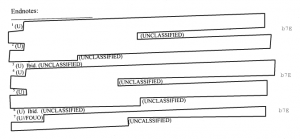Dear FBI: Show Your Work
 While we’ve been celebrating with our families, the Partnership for Civil Justice and the NYT have been reading through a set of documents showing the nationwide surveillance of Occupy Wall Street.
While we’ve been celebrating with our families, the Partnership for Civil Justice and the NYT have been reading through a set of documents showing the nationwide surveillance of Occupy Wall Street.
The documents and the FBI’s defense of them exposes several long term claims by the FBI to be false. First, that their domestic mapping program, the Domain Management Program, is not inappropriate surveillance directed at domestic politics.
An October 2011 memo from the bureau’s Jacksonville, Fla., field office was titled Domain Program Management Domestic Terrorist.
The memo said agents discussed “past and upcoming meetings” of the movement, and its spread. It said agents should contact Occupy Wall Street activists to ascertain whether people who attended their events had “violent tendencies.”
Domain Management also gets directed at Muslims and Latinos in the name of preparing to investigate terrorism and drugs. If it weren’t already clear this is about domestic spying, the inclusion of Occupy should now make that clear.
Then there’s FBI’s claim that it can’t investigate solely on the basis of speech or religion.
“The F.B.I. recognizes the rights of individuals and groups to engage in constitutionally protected activity,” said the spokesman, Paul Bresson. “While the F.B.I. is obligated to thoroughly investigate any serious allegations involving threats of violence, we do not open investigations based solely on First Amendment activity. In fact, the Department of Justice and the F.B.I.’s own internal guidelines on domestic operations strictly forbid that.”
Bresson overstates this, of course. The Domestic Investigation and Operations Guide prohibits opening an investigation solely on the basis of First Amendment activity. But it permits using such activity as part of the predicate for an investigation.
Which is why I find the FBI’s redactions so interesting.
Even the first pages of the actual documents show how FBI repeatedly acknowledged that Occupy “does not openly condone the use of violence.” But then it notes that Occupy trained for civil disobedience and its response, and from that the FBI concludes “that violence and/or illegal activity is expected by event organizers.” The FBI ascribes the violence that organizers correctly expected from cops to the organizers themselves, and used the intent to engage in civil disobedience as the means to use First Amendment activity as a predicate for investigation.
More interesting, on page 2, the FBI claims that Occupy’s website, “suggested that protestors bring ‘billy clubs and taser guns.'”
Well, that doesn’t sound like the Occupy I know (not to mention most Occupy adherents would have a tough time getting a taser gun). Luckily, the FBI included handy-dandy endnotes to show from what public sources (here, Occupy’s own website) they drew these observations.
But FBI redacted all these endnotes as a b(7)(E) exemption, which allows FBI to hide techniques used in law enforcement investigations.
These are–at least according to the claims in the document–public websites (and would have to be to be permissible under preliminary investigation rules). And yet, the FBI refuses to tell us on which public websites these claimed suggestions were made.
Probably, because that would show that FBI is using the timeworn “investigation techniques” of “drawing illogical conclusions from public claims” and “just making shit up” to invent the reason to use First Amendment activities as the predicate for an investigation.
